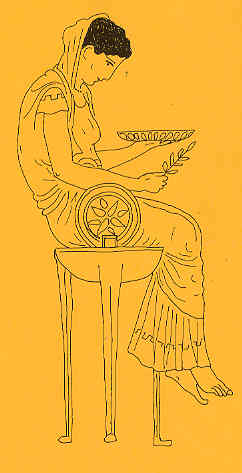Breaking the Vapour Barrier: What Made the Delphic Oracle Work?
by L.A. Curchin
The oracle of Apollo at Delphi was the most famous and reliable place of prophecy in the ancient world. Seated on a tripod in the god's temple, the priestess or Pythia uttered her predictions in a sort of inspired trance. Where did this inspiration come from? Ancient writers agree that there was a chasm under the temple that emitted intoxicating vapours. Diodorus of Sicily records that the site was first discovered by a goatherd, who noticed his animals jumping and shrieking when they looked into this opening in the ground. Upon investigating, the goatherd also began to leap about and to predict the future, and the people of Delphi built a temple to the god of prophecy on the spot. According to Strabo, the Pythia sits directly above the hole and is possessed by a gas that rises from it. Plutarch adds that the gas has a sweet odour which is sometimes strong enough to be smelled by people in the waiting room outside the adyton, the Pythia's holy chamber.

The Delphic Pythia seated on her tripod, from an Attic vase of about 440 BC
For years, scholars took these accounts at face value. However, in 1904 Adolphe Oppé, after visiting the French excavations at Delphi, published a famous article ("The Chasm at Delphi") in the Journal of Hellenic Studies, in which he dismissed the ancient tradition as a myth. He claimed that there was no chasm visible under the temple of Apollo, and that even if one had existed in ancient times, no known natural gas could have sent the Pythia into a trance. Scholars at once adopted Oppé's convincing argument, and the ancient testimony was relegated to the status of fairy tale.
Now an article in the August 2003 issue of Scientific American suggests that the ancients were right after all. Recent geological survey has discovered that two major fault lines, one running east-west (the Delphi fault) and another running southeast-northwest (the Kerna fault) intersect under the oracular chamber in the temple of Apollo. The ancient tradition of an opening in the rock below the temple was therefore correct. But what about the prophetic vapours?
The site of Delphi, and Mount Parnassus which rises behind it, are made of bituminous limestone (that is, limestone containing bitumen, a tarlike derivative of petroleum), with a petrochemical content as high as 20 percent. Analysis of spring water, rising through cracks in this limestone, shows the presence of hydrocarbon gases, among them ethylene. Moreover, analysis of calcite, a mineral deposited by this water on the limestone around the ancient temple, reveals traces of ethane, a decomposed product
of ethylene. Ethylene has a sweet odour, just as described by Plutarch. Moreover, experiments conducted in the mid-twentieth century by the American anaesthesiologist Isabella Herb found that exposure to low concentrations of ethylene would induce a trance. The patient would remain conscious, could sit up and answer questions, but would also experience euphoria (an intense feeling of pleasure and excitement) and out-of-body sensations, and in some cases would thrash about and utter wild,
unintelligible shouts. Thus ethylene, a gas occurring naturally at Delphi, could account for the strange, prophetic behaviour of the Pythia.
How would ethylene vapours be produced beneath the temple? Geological faults are lines on which two adjacent masses of rock move in different directions. This movement causes constant rubbing and friction, and if pressure builds up sufficiently, an earthquake. Such an earthquake destroyed the archaic temple of Apollo in 373 BC. The intersection of two faults provides four-way frictional activity. This friction heats the limestone to the point where the petrochemicals in it vaporize. The resulting hydrocarbon gases rise to the surface, bubbling into spring water or escaping into the open air. The Pythia, sitting stationary above the chasm in a confined chamber, would have inhaled enough ethylene to produce a trance. Variations in the amount of friction in the underlying rock would have resulted in differing degrees of gas emission, which would account for the tradition that the Pythia could only make predictions on certain days, and also for the ability of persons outside the chamber to smell the gas on some occasions.
Thus science is coming to the aid of classical texts in reviving what was until recently dismissed as a myth.